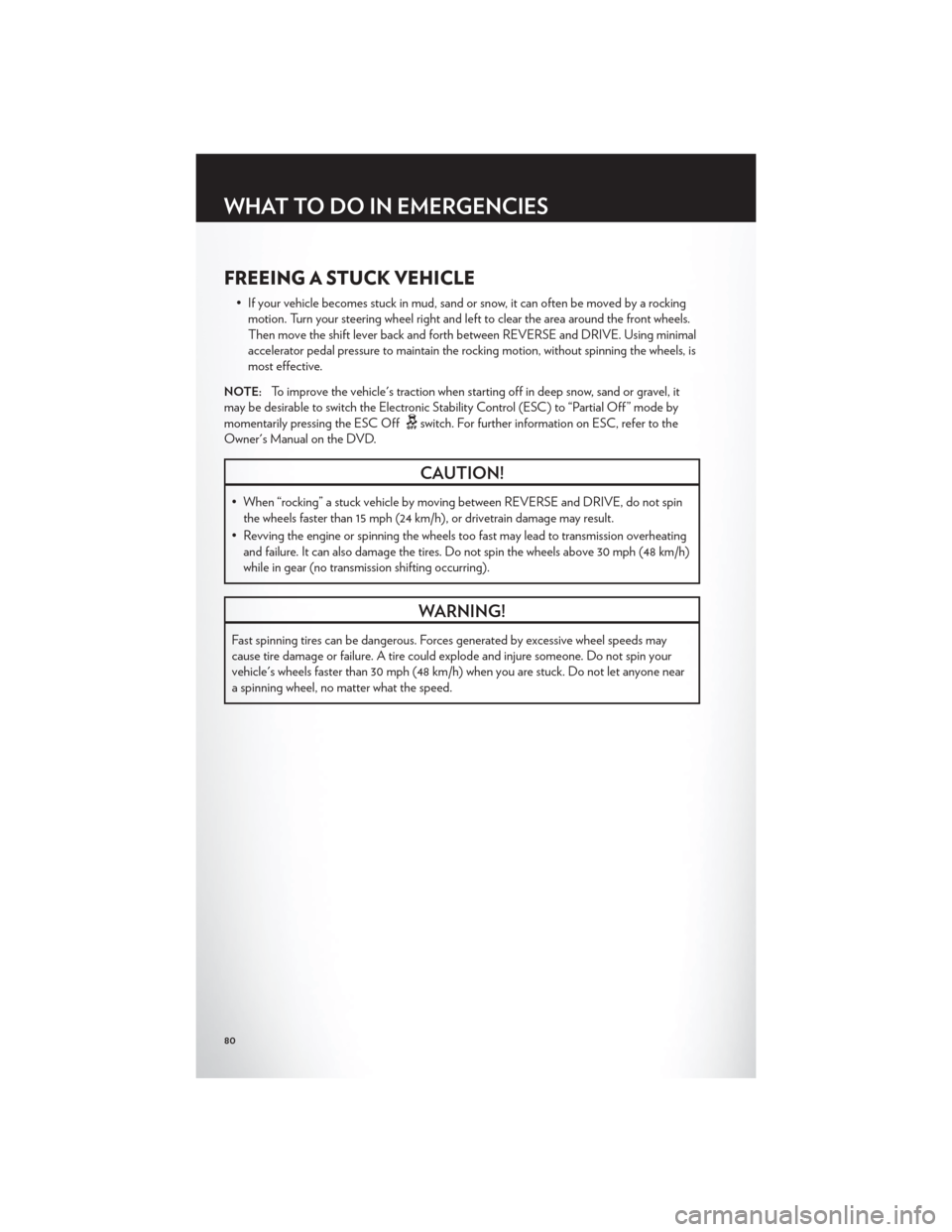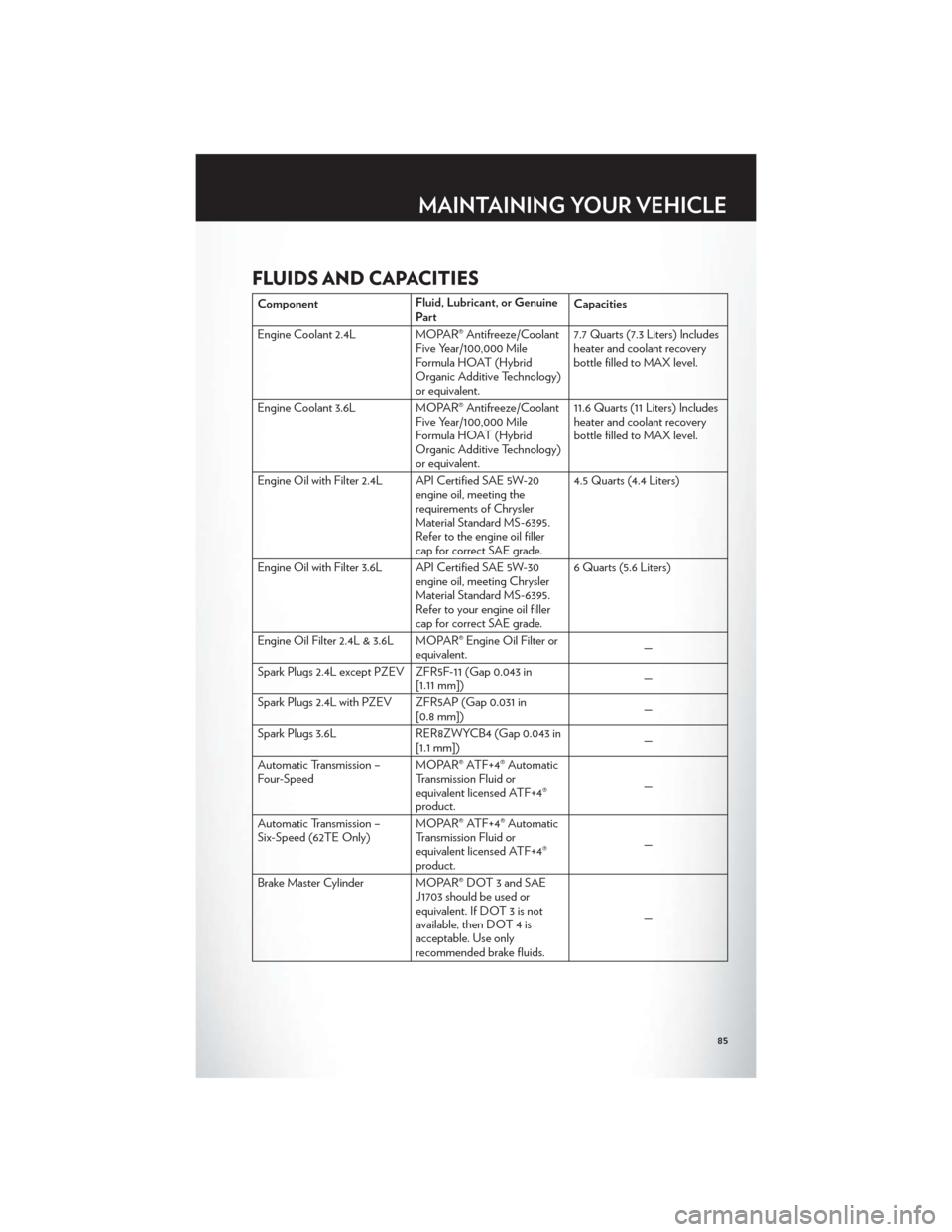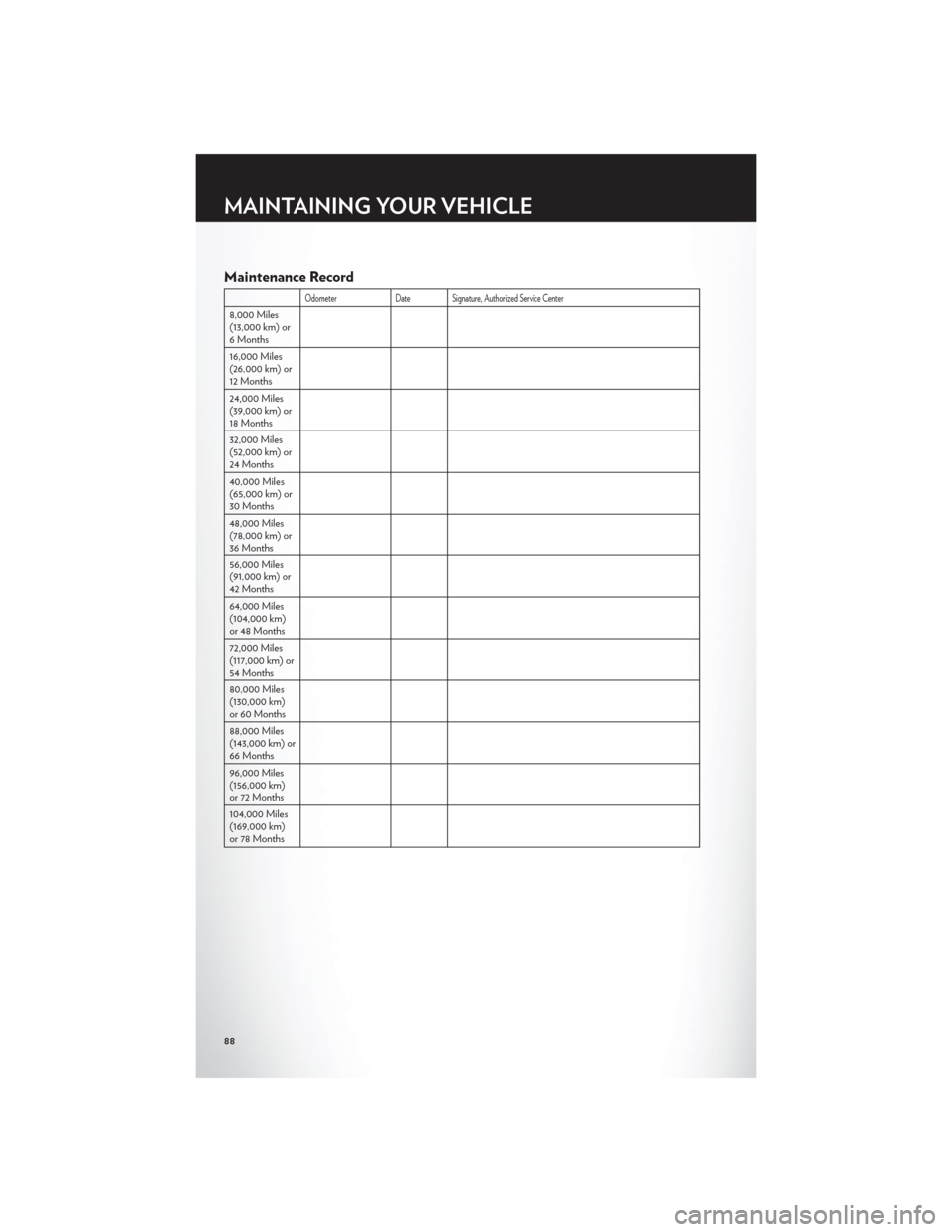CHRYSLER 200 CONVERTIBLE 2012 1.G Manual Online
Manufacturer: CHRYSLER, Model Year: 2012, Model line: 200 CONVERTIBLE, Model: CHRYSLER 200 CONVERTIBLE 2012 1.GPages: 108, PDF Size: 2.83 MB
Page 81 of 108

TOWING A DISABLED VEHICLEModelFlat Towing (all four wheels
on the ground)Flatbed Towing (all four
wheels suspended OFF the
ground)Front Wheels Raised, Rear
Wheels on the Ground
Rear Wheels Raised, Front
Wheels on the Ground
FWD Without a Key NOT Permitted
Recommended Method May Be Used NOT Permitted without a
front end dolly
FWD With a Key Shift lever must be in
NEUTRAL. The distance to
be traveled must not exceed
15 mi (25 km), and the
towing speed must not
exceed 25 mph (40 km/h).Recommended Method May Be Used
NOT Permitted without a
front end dolly
WHAT TO DO IN EMERGENCIES
79
Page 82 of 108

FREEING A STUCK VEHICLE
• If your vehicle becomes stuck in mud, sand or snow, it can often be moved by a rockingmotion. Turn your steering wheel right and left to clear the area around the front wheels.
Then move the shift lever back and forth between REVERSE and DRIVE. Using minimal
accelerator pedal pressure to maintain the rocking motion, without spinning the wheels, is
most effective.
NOTE:To improve the vehicle's traction when starting off in deep snow, sand or gravel, it
may be desirable to switch the Electronic Stability Control (ESC) to “Partial Off ” mode by
momentarily pressing the ESC Off
switch. For further information on ESC, refer to the
Owner's Manual on the DVD.
CAUTION!
• When “rocking” a stuck vehicle by moving between REVERSE and DRIVE, do not spin the wheels faster than 15 mph (24 km/h), or drivetrain damage may result.
• Revving the engine or spinning the wheels too fast may lead to transmission overheating and failure. It can also damage the tires. Do not spin the wheels above 30 mph (48 km/h)
while in gear (no transmission shifting occurring).
WARNING!
Fast spinning tires can be dangerous. Forces generated by excessive wheel speeds may
cause tire damage or failure. A tire could explode and injure someone. Do not spin your
vehicle's wheels faster than 30 mph (48 km/h) when you are stuck. Do not let anyone near
a spinning wheel, no matter what the speed.
WHAT TO DO IN EMERGENCIES
80
Page 83 of 108

EVENT DATA RECORDER (EDR)
• This vehicle is equipped with an event data recorder (EDR). The main purpose of anEDR is to record, in certain crash or near crash-like situations, such as an air bag
deployment or hitting a road obstacle, data that will assist in understanding how a
vehicle’s systems performed. The EDR is designed to record data related to vehicle
dynamics and safety systems for a short period of time, typically 30 seconds or less. The
EDR in this vehicle is designed to record such data as:
• How various systems in your vehicle were operating;
• Whether or not the driver and passenger safety belts were buckled/fastened;
• How far (if at all) the driver was depressing the accelerator and/or brake pedal; and,
• How fast the vehicle was traveling.
• These data can help provide a better understanding of the circumstances in which crashes and injuries occur.
NOTE:EDR data are recorded by your vehicle only if a non-trivial crash situation occurs; no
data are recorded by the EDR under normal driving conditions and no personal data (e.g.
name, gender, age, and crash location) are recorded. However, other parties, such as law
enforcement, could combine the EDR data with the type of personally identifying data
routinely acquired during a crash investigation.
• To read data recorded by an EDR, special equipment is required, and access to thevehicle or the EDR is needed. In addition to the vehicle manufacturer, other parties such
as law enforcement, that have the special equipment, can read the information if they
have access to the vehicle or the EDR.
WHAT TO DO IN EMERGENCIES
81
Page 84 of 108

OPENING THE HOOD
• Pull the release lever located below theinstrument panel and in front of the
driver’s door.
• Raise the hood and locate the safety latch, in the middle of the hood opening.
• Move the safety latch while lifting the hood at the same time.
• Insert the support rod into the slot on the hood.
• To close the hood, remove the support rod and place it in the retaining clip, then
lower the hood slowly.
WARNING!
Be sure the hood is fully latched before driving your vehicle. If the hood is not fully latched,
it could open when the vehicle is in motion and block your vision. Failure to follow this
warning could result in serious injury or death.
MAINTAINING YOUR VEHICLE
82
Page 85 of 108

ENGINE COMPARTMENT2.4L Engine
MAINTAINING YOUR VEHICLE
83
Page 86 of 108

3.6L Engine
MAINTAINING YOUR VEHICLE
84
Page 87 of 108

FLUIDS AND CAPACITIES
ComponentFluid, Lubricant, or Genuine
PartCapacities
Engine Coolant 2.4L MOPAR® Antifreeze/Coolant Five Year/100,000 Mile
Formula HOAT (Hybrid
Organic Additive Technology)
or equivalent.7.7 Quarts (7.3 Liters) Includes
heater and coolant recovery
bottle filled to MAX level.
Engine Coolant 3.6L MOPAR® Antifreeze/Coolant Five Year/100,000 Mile
Formula HOAT (Hybrid
Organic Additive Technology)
or equivalent.11.6 Quarts (11 Liters) Includes
heater and coolant recovery
bottle filled to MAX level.
Engine Oil with Filter 2.4L API Certified SAE 5W-20 engine oil, meeting the
requirements of Chrysler
Material Standard MS-6395.
Refer to the engine oil filler
cap for correct SAE grade.4.5 Quarts (4.4 Liters)
Engine Oil with Filter 3.6L API Certified SAE 5W-30 engine oil, meeting Chrysler
Material Standard MS-6395.
Refer to your engine oil filler
cap for correct SAE grade.6 Quarts (5.6 Liters)
Engine Oil Filter 2.4L & 3.6L MOPAR® Engine Oil Filter or equivalent. —
Spark Plugs 2.4L except PZEV ZFR5F-11 (Gap 0.043 in [1.11 mm]) —
Spark Plugs 2.4L with PZEV ZFR5AP (Gap 0.031 in [0.8 mm]) —
Spark Plugs 3.6L RER8ZWYCB4 (Gap 0.043 in
[1.1 mm]) —
Automatic Transmission –
Four-Speed MOPAR® ATF+4® Automatic
Transmission Fluid or
equivalent licensed ATF+4®
product. —
Automatic Transmission –
Six-Speed (62TE Only) MOPAR® ATF+4® Automatic
Transmission Fluid or
equivalent licensed ATF+4®
product. —
Brake Master Cylinder MOPAR® DOT 3 and SAE J1703 should be used or
equivalent. If DOT 3 is not
available, then DOT 4 is
acceptable. Use only
recommended brake fluids. —
MAINTAINING YOUR VEHICLE
85
Page 88 of 108

ComponentFluid, Lubricant, or Genuine
PartCapacities
Power Steering Reservoir MOPAR® Power Steering Fluid+4orMOPAR®ATF+4®
Automatic Transmission Fluid
or equivalent licensed ATF+4®
product. —
Fuel Selection – All Engines
(except 2.4L PZEV) 87 Octane
16.9 Gallons (64 Liters)
(Approximate)
Fuel Selection 2.4L PZEV 87 Octane 18.5 Gallons (70 Liters)
(Approximate)
E-85 Flexible Fuel – 3.6L Engine Only
CAUTION!
Only vehicles with the E-85 fuel filler door label or a yellow gas cap can operate on E-85.
• Refer to your Owner's Manual on the DVD for further details.
MAINTAINING YOUR VEHICLE
86
Page 89 of 108

MAINTENANCE CHART
Miles: 8,000 16,000 24,000 32,000 40,000 48,000 56,000 64,000 72,000 80,000 88,000 96,000 104,000
Or Months: 6 12 18 24 30 36 42 48 54 60 66 72 78
Or Kilometers: 13,000 26,000 39,000 52,000 65,000 78,000 91,000 104,000 117,000 130,000 143,000 156,000 169,000
Change the engine oil and filter. XXXXXXXXXXXXX
Rotate the tires, rotate at the first sign of irregular wear, even if it
occurs before scheduled maintenance. XXXXXXXXXXXXX
If using your vehicle for any of the following: dusty or off-road
conditions. Inspect the engine air cleaner filter; replace if neces-
sary. XXX
Inspect the brake linings; replace if necessary. XXXXXX
Replace the air conditioning filter. XXXXXX
Inspect the CV joints. XXXX
Inspect the exhaust system. XXXXX
Inspect the front suspension, tie rod ends and boot seals for
cracks or leaks and all parts for damage, wear, improper loose-
ness or end play; replace if necessary. XXXXXX
Replace the engine air cleaner filter. XXX
Replace the spark plugs (2.4L Engines) XXX
Replace the spark plugs (2.4L PZEV Engines Only) X
Replace the spark plugs (3.6L Engines) X
Adjust parking brake on all vehicles equipped with four wheel
disc brakes. XXX
Change the automatic transmission fluid & filter if using your
vehicle for any of the following: police, taxi, fleet, or frequent
trailer towing. X
Inspect and replace PCV valve if necessary. X
Flush and replace the engine coolant at 60 months or
104,000 miles (169,000 km) whichever comes first. X
Flush and replace the engine coolant at 104,000 miles
(169,000 km) or 60 months whichever comes first. X
• Refer to the Owner's Manual on the DVD for the complete maintenance schedule.
MAINTAINING YOUR VEHICLE
87
Page 90 of 108

Maintenance Record
OdometerDateSignature, Authorized Service Center
8,000 Miles
(13,000 km) or
6 Months
16,000 Miles
(26,000 km) or
12 Months
24,000 Miles
(39,000 km) or
18 Months
32,000 Miles
(52,000 km) or
24 Months
40,000 Miles
(65,000 km) or
30 Months
48,000 Miles
(78,000 km) or
36 Months
56,000 Miles
(91,000 km) or
42 Months
64,000 Miles
(104,000 km)
or 48 Months
72,000 Miles
(117,000 km) or
54 Months
80,000 Miles
(130,000 km)
or 60 Months
88,000 Miles
(143,000 km) or
66 Months
96,000 Miles
(156,000 km)
or 72 Months
104,000 Miles
(169,000 km)
or 78 Months
MAINTAINING YOUR VEHICLE
88